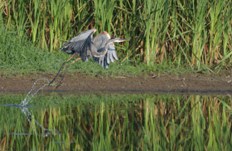Teachers' Domain - Digital Media for the Classroom and Professional Development
User: Preview

Source: Swamps and Such



The Ohio Digital Classroom helps students and educators succeed through the educational use of media-on-demand.
Swamps and Such. This video series from WOSU Public Media uses the example of a wetland to explain the structure and functions of ecosystems and how ecosystems change over time. In these videos meet wetland scientist Dan Fink who hosts the program and examines the types of communities of plants, animals, birds and fish that abound in wetlands, the process of photosynthesis, and the complex relationship between water and productivity. Developed in collaboration with The Ohio State University Olentangy River Wetlands and Research Park in Columbus, Ohio, this program was videotaped entirely at the Olentangy River Wetlands.
Chapter 1 - Active and Passive Processes of Wetlands. Click on "View" to the left to play.
Chapter 2 - Wetland Sediments (Video)
Chapter 3 - Phosphorus in Wetlands (Video)
Chapter 4 - Biochemistry of Wetlands (Video)
Lesson Plan (Document)
Nature's Kidneys. Kidneys are the body’s natural filtering system. They are able to filter out waste and excess nutrients from the bloodstream. Wetlands do a similar function for the landscape. They are responsible for the filtration and purification of water that passes though them by trapping sediments thus giving plants and microorganisms a chance to biodegrade pollutants. Wetlands also serve as a temporary storage of water helping prevent flooding and promote groundwater recharge. Some of the richest and most diverse ecosystems on earth can be found in wetlands.
Wetlands today are facing some serious problems. With increasing populations the need for land is growing and wetlands are often filled in for development purposes. When wetlands are lost to development projects, the ecosystem loses a natural process for cleaning water and preventing floods.
 Loading Standards
Loading Standards